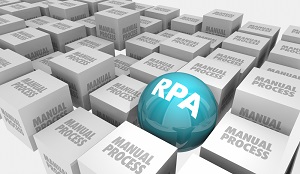Robotic Process Automation (RPA) underpins any number of vital enterprise capabilities, from functioning as a self-service portal for cognitive computing to enabling organizations to accomplish more with fewer resources.
Its foremost advantage, however, (which is contiguous to both of the aforementioned benefits) is its consistent capacity to surmount the unstructured data problem with which organizations have been struggling ever since big data emerged.
Even better, these digital agents are able to do so in a way credited with “turning that unstructured and semi-structured data into structured data that can then be used by RPA to enable various processes,” acknowledged Automation Anywhere VP of Product Marketing Kashif Mahbub.
Equipping bots with various aspects of Artificial Intelligence is foundational to making unstructured content as accessible and user friendly to organizations as their valued structured content is.
Empowering these agents with aspects of computer vision and other machine learning capabilities allows organizations to conquer the unstructured data problem by “providing intelligent automation as the [centerpiece] of your day to day front line workers, whether they’re in the front office or in the back office, and really enabling them in a way that they can’t even tell they’re using automation,” Mahbub divulged.
Or, it might be inferred, that they’re also training AI models, deploying them, and besting unwieldy unstructured data.
Computer Vision
The deluge of documents, forms, and files (whether digital or otherwise) are directly responsible for the swell of unstructured content organizations are contending with in verticals from financial services to healthcare—which happen to be highly regulated, making it imperative this content is processed correctly. Computer vision is instrumental in accelerating the rate at which this material is processed by assisting with the extraction of information from such sources.
When paired with additional facets of statistical AI, computer vision enables “a bot to extract, for instance, handwritten text before entering the data into a medical system in the case of clinical forms to expedite the patient onboarding process,” Mahbub explained. This use case is particularly relevant because of the criticality of health concerns to contemporary society, both domestically and abroad. Computer vision plays an integral role in the digital workforce’s ability to “read the form in a patient’s handwriting [and] convert it into structured information that can then kick off a bot to fill out that information in a healthcare system,” Mahbub said.
Model Refinement
Machine learning models (which form the basis of computer vision) are essential for converting unstructured content into structured content to automate almost any organizational process. RPA allows the business to tailor their use—by providing a final layer of training—to its own particular needs, such as managing the unstructured content for invoice processing, for example. This lengthy, detailed use case includes numerous steps like “opening an email, detaching the invoice pdf that’s attached to that email, storing it in a folder, double-clicking on it, opening it, then logging into SAP, maybe in an Oracle system, filling the information out in that system, populating some data here, and then going through the usual steps of processing that invoice,” Mahbub enumerated.
RPA platforms deploy machine learning to first observe, then duplicate, these elaborate measures. The notion of human in the loop is imperative for perfecting each of these steps to achieve outcomes at enterprise standards. Once a virtual agent initially performs these procedures “the processing expert is then correcting any mistakes that it makes and that information gets stored; this is through machine learning,” Mahbub explained. “After a few of these corrections on a single invoice, the system then knows where to find the correct information on this piece of paper, an invoice which might be attached as a pdf.”
Scalable Accuracy
After digital workers perfect these tasks for specific use cases like processing invoices or insurance claims, they’re readily deployed at scale to increase the magnitude of work performed. Completing forms for clinical trials provides an excellent example of the scalability of intelligent process automation. Since an intelligent bot can observe human action and incorporate corrections into future iterations for any use case, “as it learns more the straight through processing gets better and better,” Mahbub reflected. “We’ve seen it go from 30 percent to 90 plus percent, getting closer and closer to 100 percent in terms of how much processing the system does and how well the system does in terms of unlocking and understanding the information locked in those documents.”
Intelligent Resilience
Another noteworthy dimension of synthesizing RPA and computer vision is the resiliency they inherently support, particularly when changes arise to the forms or screens from which bots manipulate unstructured content. When coupled with additional types of machine learning, the various aspects of computer vision enable bots to understand the underlying content they process—including where it appears. Mahbub articulated a use case in which the fields for names on a mortgage application, for example, were moved on the form. In this situation “the computer vision process understands where the field is and the new location to get the right data, and then use it for more machine learning,” Mahbub commented. This approach enables digital workers to maintain a degree of adaptability to new circumstances that’s invaluable to working with unstructured content at scale while “not letting the bot drift,” Mahbub said.
What Lies Ahead
Accounting for the rigors of unstructured content is one of the foremost challenges for any organization. The capacity to convert it into a structured form that’s recognized by internal IT systems and used in daily operations is of immeasurable value to the enterprise. RPA repeatedly achieves this objective by utilizing various forms of machine learning, computer vision, and other cognitive computing methods that demonstrate their worth to innumerable core processes.
Tantamount to this advantage is the implicit benefit of democratizing the adoption of cognitive technologies via bots. Machine learning models are no longer confined to the data scientist’s sandbox. When coupled with RPA, any business user can leverage machine learning and other vanguard technologies to overcome the difficulties of unstructured data, as well as additional challenges in the ever evolving data ecosystem. This combination “is enabling any and all citizen developers, your business users, your non-technical team members, if you well,” Mahbub mentioned. “Their numbers are way bigger than just your developers in your organization.”
About the Author

Jelani Harper is an editorial consultant servicing the information technology market. He specializes in data-driven applications focused on semantic technologies, data governance and analytics.
Sign up for the free insideAI News newsletter.





Speak Your Mind